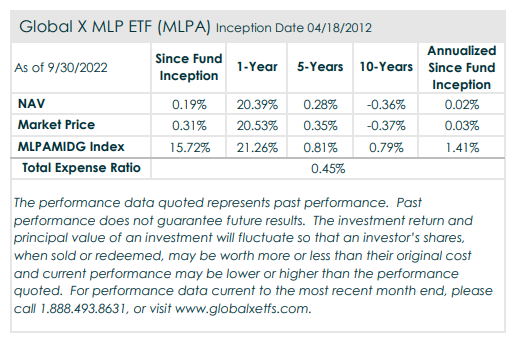The December MLP Monthly Report can be found here offering insights on MLP industry news, the asset class’s performance, yields, valuations, and fundamental drivers.
The latest quarterly MLP Insights piece providing analysis into the midstream space can be found here as well.
Summary
News:
1) OPEC+ has decided to stick to its existing policy of reducing oil production by 2 million barrels per day from November to end-2023. Several members of OPEC and its allies have voiced their displeasure with the G7 cap on Russian seaborne oil, stating that the West may eventually use the anti-market move against any producer.
2) After several days of intense negotiations, the European Union agreed to cap Russian seaborne oil prices at $60 per barrel. The move came after the G-7 group decided in September to impose a limit on Russian seaborne crude, restricting Russia’s revenue from the commodity. However, the price limit will be reviewed regularly to monitor its market implications, but it is expected to be at least 5% lower than the average market price.
3) Chevron received an expanded U.S. license for six months, which is expected to be renewed monthly after that, allowing it to resume production in Venezuela and import crude from South America to the U.S. The decision will enable Chevron to continue operations in existing oil projects in the U.S.-sanctioned country and bring new oil supplies to U.S. refiners. However, the agreement restricts cash payments to Venezuela, which may negatively impact the amount of oil available to Chevron.
Sources: Meredith, S. (2022, December 4). OPEC+ agrees to stick to its existing policy of reducing oil production ahead of Russia sanctions. CNBC.; Lawler, A., Ghaddar, A., & Astakhova, O. (2022, December 5). OPEC+ keeps steady policy amid weakening economy, Russian oil cap. Reuters.; Amaro, S. (2022, December 2). European Union officials set Russian oil price cap at $60 a barrel. CNBC.; Psaledakis, D., & Parraga, M. (2022, November 27). Chevron can resume key role in Venezuela’s oil output, exports. Reuters.
Performance: Midstream MLPs, as measured by the Solactive MLP Infrastructure Index, increased by 0.01% last month. The index increased by 41.54% since last November. (Source: Bloomberg)
Yield: The current yield on MLPs stands at 7.34%. MLP yields remained higher than both the broad market benchmarks for Investment Grade Bonds (5.31%), Fixed Rate Preferreds (7.02%) and lower than the Emerging Market Bonds (7.59%) and High Yield Bonds (8.65%).2 MLP yield spreads versus 10-year Treasuries currently stand at 3.44%, lower than the long-term average of 5.65%.(Sources: Bloomberg; Board of Governors of the Federal Reserve System. (2022, November 30). Preformatted package: Treasury constant maturities [Data set]. Data Download Program.)
Valuations: The Enterprise Value to EBITDA ratio (EV-to-EBITDA), which seeks to provide more color on the valuations of MLPs, decreased by 1.12% last month. Since November 2021, the EV-to-EBITDA ratio is up by approximately 2.54%. (Source: Bloomberg)
Crude Production: The Baker Hughes Rig Count increased to 784 rigs, increasing by 16 rigs from last month’s count of 768 rigs. US production of crude oil increased to 12.100 mb/d in the last week of November compared to October levels of 11.900 mb/d. (Sources: Baker Hughes. (2022, December 15). North America rig count.; U.S. Energy Information Administration. (2022, December 15). Petroleum and other liquids.)

For performance data current to the most recent month- and quarter-end, please click here.
MLPA does not have any holding in Chevron Corp.
DEFINITIONS
Solactive MLP Infrastructure Index: The Solactive MLP Infrastructure Index is intended to give investors a means of tracking the performance of the energy infrastructure MLP asset class in the United States. The index is composed of Midstream MLPs engaged in the transportation, storage, and processing of natural resources.
S&P MLP Index: S&P MLP Index provides investors with exposure to the leading partnerships that trade on the NYSE and NASDAQ. The index includes both master limited partnerships (MLPs) and publicly traded limited liability companies (LLCs), which have a similar legal structure to MLPs and share the same tax benefits
Bloomberg US Corporate High Yield Total Return Index: The Bloomberg US Corporate High Yield Bond Index measures the USD-denominated, high yield, fixed-rate corporate bond market. Securities are classified as high yield if the middle rating of Moody’s, Fitch and S&P is Ba1/BB+/BB+ or below. Bonds from issuers with an emerging markets country of risk, based on Bloomberg EM country definition, are excluded.
ICE BofA Fixed Rate Preferred Securities Index: The ICE BofA Fixed Rate Preferred Securities Index tracks the performance of fixed rate US dollar denominated preferred securities issued in the US domestic market.
Bloomberg EM USD Aggregate Total Return Index: The Bloomberg Emerging Markets Hard Currency Aggregate Index is a flagship hard currency Emerging Markets debt benchmark that includes USD-denominated debt from sovereign, quasi-sovereign, and corporate EM issuers.
Bloomberg US Corporate Total Return Index: The Bloomberg US Corporate Total Return Value Unhedged Index measures the investment grade, fixed-rate, taxable corporate bond market. It includes USD denominated securities publicly issued by US and non-US industrial, utility and financial issuers.
Crude Oil: Measured based on the Generic 1st ‘CL’ Future, which is the nearest crude oil future to expiration.
EBITDA: Earnings before interest, tax, depreciation and amortization (EBITDA) is a measure of a company’s operating performance. Essentially, it’s a way to evaluate a company’s performance without having to factor in financing decisions, accounting decisions or tax environments.
Average Spread: Average spread is the average of the excess of the MLPs yield over the 10 year treasuries yield.
Enterprise Value (EV): EV is a measure of a company’s total value, often used as a more comprehensive alternative to equity market capitalization.
 Rohan Reddy
Rohan Reddy